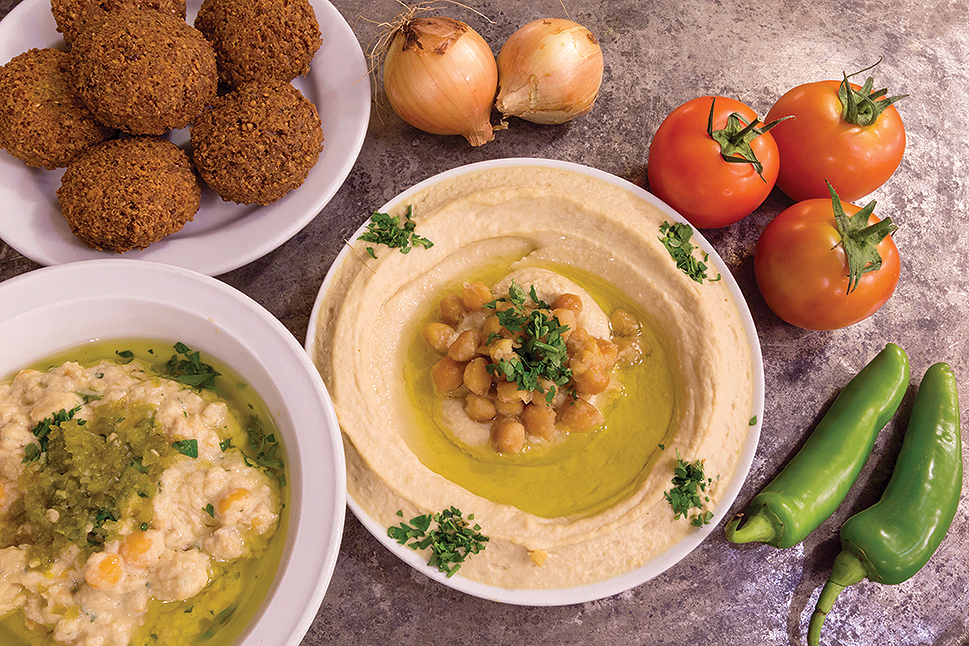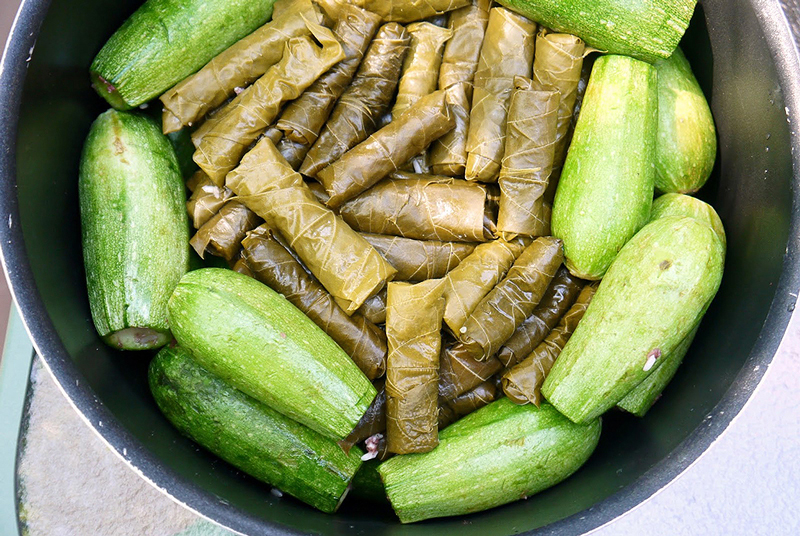
Palestinian cuisine has its own unique character and includes a large variety of homemade dishes that are enjoyed during family gatherings, social functions, holidays, and feasts.
The mezza, or “hors d’oeuvre” is commonly eaten with fresh bread (khubz), whether it’s pita, shrak, or taboon. This variety of appetizers is served at the beginning of a meal, using various fresh vegetables in season and fresh leafy greens, especially during spring. Greens include khobbeizeh (wild mallow), hindbeh (dandelion leaves), hwerneh (mustard greens), jarjeer (arugula or rocca), Swiss chard (beet), baqleh (purslane), spinach, and green za’atar (wild thyme).
Tahini – crushed sesame seeds known to humanity for over 700 years – is the most common ingredient in the mezza. It is used in salads, dips, hummus, and baba ghanoush (roasted eggplant). One must not forget the deep-fried falafel that is bought on the streets of Palestinian cities and served as a light meal with pita bread, a variety of salads, and dips; or shawarma, made with lamb, poultry, or veal.
Palestinian cuisine uses garlic, onion, and olive oil, which are healthy and tasty. Other essential ingredients include a variety of fresh herbs such as mint, parsley, and coriander, and spices such as cardamom, black pepper, and sumac. Sumac is a must with musakhan – typically eaten with one’s hands – which consists of roasted chicken on a round of taboon bread and topped with strips of onions sautéed in olive oil and sumac, and garnished with toasted pine nuts. While the city of Jenin is known for its delicious musakhan, qidreh (rice with chickpeas) is a common dish in the Hebron area.
Sumac can also be used in salads, but tabouleh requires burghul or crushed wheat. Maqluba, which means upside down, is the name of a common dish in the Jerusalem area. It is served with rice, eggplant, or cauliflower casserole, accompanied with lamb, beef, or chicken. Lentils, freekeh, burghul, rice, couscous, and potatoes are main-dish staple ingredients.
At the end of each meal, sweets such as knafeh and qatayef (mostly during Ramadan) are served. Qatayef are pastries filled with sweetened white cheese or nuts. Other sweets include ka’ek and ma’moul, traditional Easter delicacies that are filled with dates or various nuts such as almonds, walnuts, or pistachios; muhalabiyeh (rice pudding); and harissa (semolina cake). Popular Palestinian beverages include chilled juices made from carob, tamarind, or almonds; fresh lemonade; and arq sous (licorice.)
Finally, a meal is not complete without the qahwe (Turkish coffee with cardamom) or istikanet shay (a small cup of tea with fresh mint).
Bon appetit, bil hana wishifa!
» With 35 years of professional experience in culinary arts and food science, Chef Nabil Aho is the head chef instructor at the Professional Promotion Hospitality Section of Notre Dame of Jerusalem Center. Between 2003 and 2005, he served as executive chef at Notre Dame of Jerusalem Center. In addition to being a consultant in culinary services, he is a co-founder and active member of Chefs for Peace. In 2015, he published an international glossary of kitchen and food terms in English and Arabic.



